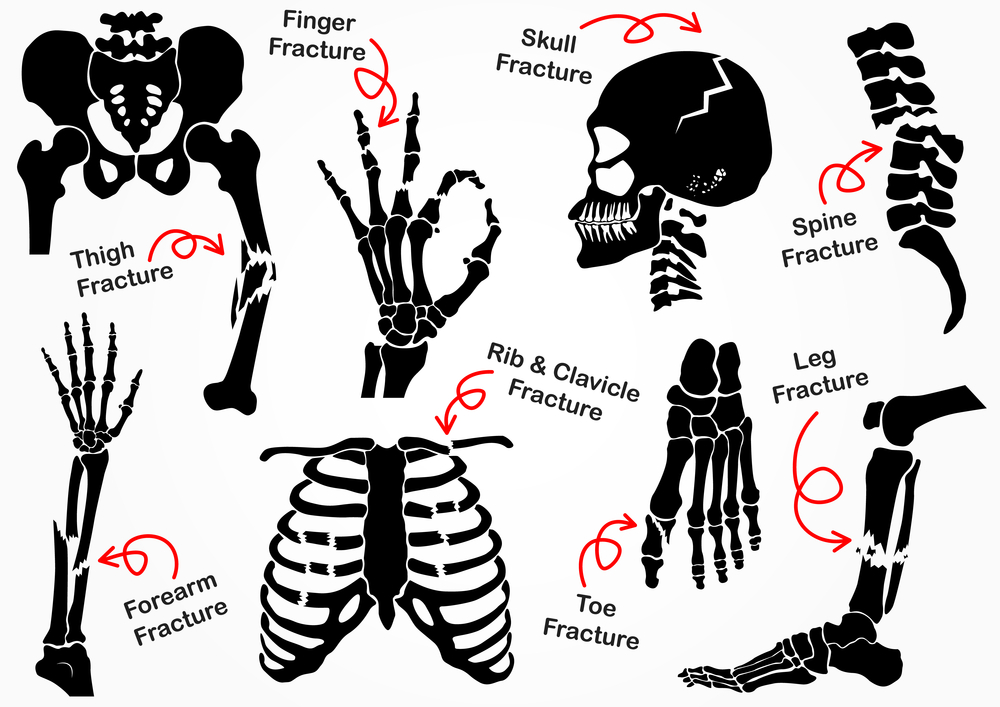“You’ve fractured a bone.” Probably the last thing anyone wants to hear when the doctor or nurse in the emergency department approaches you following an x-ray. Not two hours earlier, you’ve gone into a 50/50 challenge on the pitch with an opponent and came out feeling something wasn’t quite right. Who would have thought a simple, unintended stamp on the foot could lead to so much pain?!
Sometimes it is obvious you have fractured a bone. If you have an accident or fall and look down and your immediate reaction is hmm… my leg or wrist is usually much straighter than that, then there is a good chance you have fractured a bone. Other times, it may not be so obvious. Take for example the stamp on the foot scenario above or taking an impact into the ribs or spine. These may not leave your body deformed, but it doesn’t mean a fracture hasn’t occurred. There are usually some tell-tale signs and symptoms that go alongside a traumatic event. Pain and not being able to use the body part as you normally would are big ones. There may also be evidence of bruising or swelling, although these do not always appear right away.
What is a fracture?
A fracture is a broken bone. Many people think fractured and broken bones are different, but they are not. As we move around this world in our own little human way, our bodies are subjected to forces acting upon them from the environment around us. Most of the time we don’t even notice these forces acting upon us as our bodies just soak them up as we go about our daily tasks. If the forces increase in strength (E.g. an angry opponent taking you out on the rugby field while you are running at top speed), we may then notice them. Ouch! If the force becomes too great for our bodies to handle, that’s when more serious injury occurs. For a muscle, tendon or ligament, a tear or rupture occurs. When bone is involved, it fractures. Bones can fracture in many ways, with some being more serious than others.
Types of fracture
There are many different types of bone fracture. Let’s get familiar with them, as the lingo can help you to understand what has happened:
- Simple / closed: The bone breaks without breaking through the skin.
- Compound / open: The bone breaks through the skin. There is a high risk of infection with these types of fractures.
- Non-displaced / stable: The bone breaks but the pieces maintain alignment.
- Displaced / unstable: The bone breaks and the pieces lose alignment. Unstable fractures usually require surgery to correct.
- Transverse: The break occurs straight across the shaft of the bone.
- Linear: The break occurs straight along the shaft of the bone.
- Oblique: The break occurs diagonally across the shaft of the bone.
- Spiral: The fracture line twists around the bone shaft, usually the result of a strong twisting force placed on the bone.
- Comminuted: There are several bone fragments — a complicated and serious!
- Impacted: Two parts of a bone are driven into one another.
- Greenstick: Seen in children where the skeleton is still quite flexible and has not transitioned completely from cartilage to bone. This is a partial fracture where one side of the bone breaks, but the other side stays intact.
- Compression: Most seen in the spine where two vertebrae are forced against one another leading to collapse of the body of the bones.
- Stress: An overuse injury. A small, repetitive stress is placed on a bone over and over until a small crack appears. These can then progress if left untreated.
- Avulsion: These occur when a forceful muscle contraction creates a strong pull, breaking away the bone underlying the tendon of the muscle.
- Pathological: These are fractures that occur due to the presence of an underlying medical condition such as cancer or osteoporosis.
There are a lot of words, but as an example, it is possible to have a non-displaced transverse fracture of your femur (thighbone). It is also possible to have a displaced transverse fracture of your femur. The difference being the two parts of the bone remain aligned in one, but not aligned in the other.
Can my osteo help?
We can absolutely help you recover from a bone fracture. We are unlikely to be your first port of call when you fracture a bone unless the underlying cause of your pain is a stress fracture. We do often see these before they are diagnosed by an x-ray or bone scan. Most people end up in the emergency department of a hospital following a fracture, and then once the initial period of healing is over, they will consult an osteopath for further help. Following a fracture, the muscles and joints close to the break will have been affected, decreasing your ability to move that body part. This is where we come in!
Recently fractured a bone and have been given the all-clear to start rehabilitating? Consult us today by calling (03) 8360 8363. We’ll see your bones (and the rest of you) back to full health!

